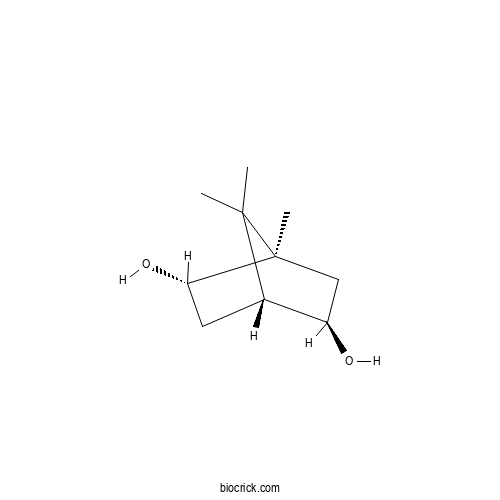5-exo-HydroxyborneolCAS# 32751-73-8 |

Quality Control & MSDS
3D structure
Package In Stock
Number of papers citing our products

| Cas No. | 32751-73-8 | SDF | Download SDF |
| PubChem ID | 7140311 | Appearance | Powder |
| Formula | C10H18O2 | M.Wt | 170.2 |
| Type of Compound | Other Terpenoid | Storage | Desiccate at -20°C |
| Solubility | Soluble in Chloroform,Dichloromethane,Ethyl Acetate,DMSO,Acetone,etc. | ||
| Chemical Name | (1R,2S,4R,5R)-1,7,7-trimethylbicyclo[2.2.1]heptane-2,5-diol | ||
| SMILES | CC1(C2CC(C1(CC2O)C)O)C | ||
| Standard InChIKey | HLVIHBJQDKVEAL-ODHVRURNSA-N | ||
| Standard InChI | InChI=1S/C10H18O2/c1-9(2)6-4-8(12)10(9,3)5-7(6)11/h6-8,11-12H,4-5H2,1-3H3/t6-,7+,8-,10-/m0/s1 | ||
| General tips | For obtaining a higher solubility , please warm the tube at 37 ℃ and shake it in the ultrasonic bath for a while.Stock solution can be stored below -20℃ for several months. We recommend that you prepare and use the solution on the same day. However, if the test schedule requires, the stock solutions can be prepared in advance, and the stock solution must be sealed and stored below -20℃. In general, the stock solution can be kept for several months. Before use, we recommend that you leave the vial at room temperature for at least an hour before opening it. |
||
| About Packaging | 1. The packaging of the product may be reversed during transportation, cause the high purity compounds to adhere to the neck or cap of the vial.Take the vail out of its packaging and shake gently until the compounds fall to the bottom of the vial. 2. For liquid products, please centrifuge at 500xg to gather the liquid to the bottom of the vial. 3. Try to avoid loss or contamination during the experiment. |
||
| Shipping Condition | Packaging according to customer requirements(5mg, 10mg, 20mg and more). Ship via FedEx, DHL, UPS, EMS or other couriers with RT, or blue ice upon request. | ||

5-exo-Hydroxyborneol Dilution Calculator

5-exo-Hydroxyborneol Molarity Calculator
| 1 mg | 5 mg | 10 mg | 20 mg | 25 mg | |
| 1 mM | 5.8754 mL | 29.3772 mL | 58.7544 mL | 117.5088 mL | 146.886 mL |
| 5 mM | 1.1751 mL | 5.8754 mL | 11.7509 mL | 23.5018 mL | 29.3772 mL |
| 10 mM | 0.5875 mL | 2.9377 mL | 5.8754 mL | 11.7509 mL | 14.6886 mL |
| 50 mM | 0.1175 mL | 0.5875 mL | 1.1751 mL | 2.3502 mL | 2.9377 mL |
| 100 mM | 0.0588 mL | 0.2938 mL | 0.5875 mL | 1.1751 mL | 1.4689 mL |
| * Note: If you are in the process of experiment, it's necessary to make the dilution ratios of the samples. The dilution data above is only for reference. Normally, it's can get a better solubility within lower of Concentrations. | |||||

Calcutta University

University of Minnesota

University of Maryland School of Medicine

University of Illinois at Chicago

The Ohio State University

University of Zurich

Harvard University

Colorado State University

Auburn University

Yale University

Worcester Polytechnic Institute

Washington State University

Stanford University

University of Leipzig

Universidade da Beira Interior

The Institute of Cancer Research

Heidelberg University

University of Amsterdam

University of Auckland

TsingHua University

The University of Michigan

Miami University

DRURY University

Jilin University

Fudan University

Wuhan University

Sun Yat-sen University

Universite de Paris

Deemed University

Auckland University

The University of Tokyo

Korea University
- (+/-)-N-methylcoclaurine
Catalog No.:BCN0458
CAS No.:1472-62-4
- Bis(2-ethylhexyl) terephthalate
Catalog No.:BCN0457
CAS No.:6422-86-2
- Toxyloxanthone B
Catalog No.:BCN0456
CAS No.:50875-24-6
- V1 iridoid
Catalog No.:BCN0455
CAS No.:87441-71-2
- Acronyculatin Q
Catalog No.:BCN0454
CAS No.:2287183-54-2
- Mecambridine
Catalog No.:BCN0453
CAS No.:31098-60-9
- Acropyrone
Catalog No.:BCN0452
CAS No.:1381875-14-4
- Furanofukinin
Catalog No.:BCN0451
CAS No.:34335-93-8
- 6-O-Ethyltetradymodiol
Catalog No.:BCN0450
CAS No.:1028530-06-4
- 6β-Ethoxyfuranoeremophilane
Catalog No.:BCN0449
CAS No.:82462-36-0
- Phenylacetylglycine
Catalog No.:BCN0448
CAS No.:500-98-1
- N1-Methyl-2-pyridone-5-carboxamide
Catalog No.:BCN0447
CAS No.:701-44-0
- 3,8-Di-O-methylellagic acid 2-O-(5'-O-acetyl)arabinofuranoside
Catalog No.:BCN0460
CAS No.:365540-09-6
- 4,5-Dioxodehydroasimilobine
Catalog No.:BCN0461
CAS No.:82644-81-3
- 2,4-Dihydroxy-6-methoxy-3,5-diprenylacetophenone
Catalog No.:BCN0462
CAS No.:123999-38-2
- Alpinigenine
Catalog No.:BCN0463
CAS No.:14028-91-2
- Tabernaecorymbosine A
Catalog No.:BCN0464
CAS No.:1262306-81-9
- Flindulatin
Catalog No.:BCN0465
CAS No.:521-44-8
- (±)-Cleroindicin F
Catalog No.:BCN0466
CAS No.:94535-01-0
- p-O-Farnesylcoumaric acid
Catalog No.:BCN0467
CAS No.:939769-47-8
- 6,4'-Dihydroxy-5,7-dimethoxyflavanone
Catalog No.:BCN0468
CAS No.:6951-57-1
- 5-endo-Hydroxyborneol
Catalog No.:BCN0469
CAS No.:68738-10-3
- 1-O-p-Coumaroylglucose
Catalog No.:BCN0470
CAS No.:7139-64-2
- 1-O-Cinnamoylglucose
Catalog No.:BCN0471
CAS No.:40004-96-4
Chemoenzymatic Synthesis of a Novel Borneol-Based Polyester.[Pubmed:28772002]
ChemSusChem. 2017 Sep 22;10(18):3574-3580.
Terpenes are a class of natural compounds that have recently moved into the focus as a bio-based resource for chemical production, owing to their abundance, their mostly cyclic structures, and the presence of olefin or single hydroxy groups. To apply this raw material in new industrial fields, a second hydroxy group is inserted into borneol by cytochrome P450cam (CYP101) enzymes in a whole-cell catalytic biotransformation with Pseudomonas putida KT2440. Next, a semi-continuous batch system was developed to produce 5-exo-Hydroxyborneol with a final concentration of 0.54 g L(-1) . The bifunctional terpene was then used for the synthesis of a bio-based polyester by a solvent-free polycondensation reaction. The resulting polymer showed a glass transition temperature of around 70 degrees C and a molecular weight in the range of 2000-4000 g mol(-1) (Mw ). These results show that whole-cell catalytic biotransformation of terpenes could lead to bio-based, higher-functionalized monomers, which might be basic raw materials for different fields of application, such as biopolymers.
Biotransformation of (-)-borneol by cultured cells of Eucalyptus perriniana.[Pubmed:7764236]
Phytochemistry. 1993 Nov;34(4):1045-8.
Six new biotransformation products, (-)-borneol 2-O-beta-gentiobioside, (-)-borneol 2-O-beta-sophoroside, (-)-borneol 2',6'-di-O-(beta-D-glucopyranosyl)-beta-D-glucopyranoside, 6-exo-hydroxyborneol 2-O-beta-D-glucopyranoside, 4-hydroxyborneol 2-O-beta-D-glucopyranoside and 5-exo-Hydroxyborneol 2-O-beta-gentiobioside, together with 5-exo-Hydroxyborneol 2-O-beta-D-glucopyranoside, were isolated from jar fermentor cultures of Eucalyptus perriniana following administration of (-)-borneol.


